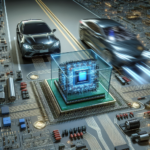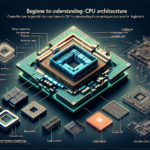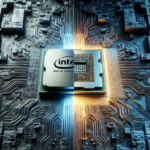Explaining the Use of CPUs in Self-Driving Cars

Explaining the Use of CPUs in Self-Driving Cars
Self-driving cars, also known as autonomous vehicles, are one of the most exciting advancements in modern technology. These vehicles rely on a complex interplay of hardware and software to navigate roads, avoid obstacles, and ensure passenger safety. At the heart of this technology lies the Central Processing Unit (CPU), a critical component that processes vast amounts of data in real-time. This article delves into the role of CPUs in self-driving cars, exploring their functions, importance, and future prospects.
The Role of CPUs in Self-Driving Cars
Data Processing and Decision Making
Self-driving cars are equipped with a myriad of sensors, including cameras, LiDAR, radar, and ultrasonic sensors. These sensors collect a continuous stream of data about the vehicle’s surroundings. The CPU processes this data to create a comprehensive understanding of the environment. This process involves:
- Object Detection: Identifying objects such as pedestrians, other vehicles, and road signs.
- Object Classification: Categorizing detected objects to understand their nature and behavior.
- Path Planning: Determining the optimal route for the vehicle to follow.
- Decision Making: Making real-time decisions based on the processed data, such as when to stop, accelerate, or change lanes.
Real-Time Performance
One of the most critical requirements for CPUs in self-driving cars is real-time performance. The CPU must process data and make decisions within milliseconds to ensure the vehicle’s safety and efficiency. This necessitates high-performance CPUs capable of handling parallel processing and complex algorithms.
Integration with Other Components
The CPU in a self-driving car does not work in isolation. It integrates with other components such as the Graphics Processing Unit (GPU), Digital Signal Processor (DSP), and specialized AI accelerators. Each of these components has a specific role:
- GPU: Handles image and video processing tasks, crucial for interpreting data from cameras.
- DSP: Processes signals from radar and ultrasonic sensors.
- AI Accelerators: Execute machine learning algorithms for tasks like object detection and path planning.
Types of CPUs Used in Self-Driving Cars
General-Purpose CPUs
General-purpose CPUs, such as those found in personal computers, are often used in the early stages of self-driving car development. These CPUs are versatile and capable of handling a wide range of tasks. However, they may not offer the specialized performance required for real-time processing in autonomous vehicles.
Automotive-Grade CPUs
As self-driving technology advances, the need for specialized automotive-grade CPUs becomes apparent. These CPUs are designed to meet the stringent requirements of the automotive industry, including:
- Reliability: Ensuring consistent performance under various conditions.
- Durability: Withstanding harsh environmental factors such as temperature fluctuations and vibrations.
- Safety: Incorporating features like redundancy and fail-safe mechanisms to enhance safety.
High-Performance CPUs
High-performance CPUs, often used in conjunction with GPUs and AI accelerators, are essential for Level 4 and Level 5 autonomous vehicles. These CPUs offer the computational power needed to process vast amounts of data in real-time, enabling advanced features such as:
- Full Autonomy: Allowing the vehicle to operate without human intervention.
- Advanced Driver Assistance Systems (ADAS): Providing features like adaptive cruise control, lane-keeping assistance, and automated parking.
Challenges and Solutions
Power Consumption
One of the significant challenges in using high-performance CPUs in self-driving cars is power consumption. These CPUs require substantial power, which can impact the vehicle’s overall efficiency. Solutions to this challenge include:
- Energy-Efficient Designs: Developing CPUs with lower power consumption without compromising performance.
- Optimized Algorithms: Creating algorithms that minimize computational load and power usage.
Heat Dissipation
High-performance CPUs generate significant heat, which can affect their performance and longevity. Effective heat dissipation mechanisms are crucial to maintaining optimal CPU performance. Solutions include:
- Advanced Cooling Systems: Implementing liquid cooling or advanced air cooling systems.
- Thermal Management Software: Using software to monitor and manage CPU temperature.
Latency
Latency, or the delay in data processing, is another critical challenge. In self-driving cars, even a slight delay can have severe consequences. Solutions to reduce latency include:
- Edge Computing: Processing data closer to the source to reduce transmission delays.
- Optimized Hardware: Using specialized hardware designed for low-latency performance.
Future Prospects
Advancements in CPU Technology
The future of CPUs in self-driving cars looks promising, with continuous advancements in technology. Some of the anticipated developments include:
- Quantum Computing: Leveraging quantum computing for faster and more efficient data processing.
- Neuromorphic Computing: Mimicking the human brain’s neural networks to enhance AI capabilities.
- 5G Integration: Utilizing 5G networks for faster data transmission and reduced latency.
Collaboration with AI and Machine Learning
The integration of CPUs with AI and machine learning technologies will play a crucial role in the evolution of self-driving cars. This collaboration will enable more sophisticated algorithms for object detection, path planning, and decision making, ultimately leading to safer and more efficient autonomous vehicles.
FAQ
What is the role of the CPU in a self-driving car?
The CPU in a self-driving car processes data from various sensors, makes real-time decisions, and integrates with other components like GPUs and AI accelerators to ensure safe and efficient vehicle operation.
Why is real-time performance important for CPUs in self-driving cars?
Real-time performance is crucial because the CPU must process data and make decisions within milliseconds to ensure the vehicle’s safety and efficiency. Delays in processing can lead to accidents or inefficient driving.
What types of CPUs are used in self-driving cars?
Self-driving cars use a range of CPUs, including general-purpose CPUs, automotive-grade CPUs, and high-performance CPUs. The choice depends on the level of autonomy and specific requirements of the vehicle.
What are the main challenges in using CPUs for self-driving cars?
The main challenges include power consumption, heat dissipation, and latency. Solutions involve energy-efficient designs, advanced cooling systems, and optimized hardware and algorithms.
What is the future of CPUs in self-driving cars?
The future of CPUs in self-driving cars includes advancements in quantum computing, neuromorphic computing, and 5G integration. These developments will enhance data processing capabilities and reduce latency, leading to safer and more efficient autonomous vehicles.
Conclusion
The CPU is a vital component in the complex ecosystem of self-driving cars. It processes vast amounts of data in real-time, makes critical decisions, and integrates with other specialized hardware to ensure the vehicle’s safe and efficient operation. While there are challenges such as power consumption, heat dissipation, and latency, ongoing advancements in CPU technology and collaboration with AI and machine learning promise a bright future for autonomous vehicles. As technology continues to evolve, we can expect self-driving cars to become safer, more efficient, and more reliable, revolutionizing the way we travel.




